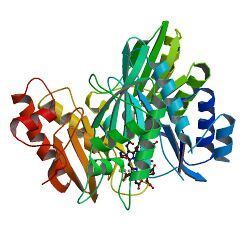Biology:Sulfite reductase
| This biology needs to be updated. Please update this biology to reflect recent events or newly available information. (January 2022) |
| sulfite reductase | |||||||||
|---|---|---|---|---|---|---|---|---|---|
 | |||||||||
| Identifiers | |||||||||
| EC number | 1.8.99.1 | ||||||||
| CAS number | 37256-51-2 | ||||||||
| Databases | |||||||||
| IntEnz | IntEnz view | ||||||||
| BRENDA | BRENDA entry | ||||||||
| ExPASy | NiceZyme view | ||||||||
| KEGG | KEGG entry | ||||||||
| MetaCyc | metabolic pathway | ||||||||
| PRIAM | profile | ||||||||
| PDB structures | RCSB PDB PDBe PDBsum | ||||||||
| Gene Ontology | AmiGO / QuickGO | ||||||||
| |||||||||
Sulfite reductases (EC 1.8.99.1) are enzymes that participate in sulfur metabolism.[1] They catalyze the reduction of sulfite to hydrogen sulfide and water.[1][2] Electrons for the reaction are provided by a dissociable molecule of either NADPH, bound flavins, or ferredoxins.[3]
- SO32− (sulfite) + electron donor [math]\displaystyle{ \rightleftharpoons }[/math] H2S (hydrogen sulfide) + oxidized donor + 3 H2O
Sulfite reductases, which belong to the oxidoreductase family, are found in archaea, bacteria, fungi, and plants.[4][5][6] They are grouped as either assimilatory or dissimilatory sulfite reductases depending on their function, their spectroscopic properties, and their catalytic properties. This enzyme participates in selenoamino acid metabolism and sulfur assimilation. It employs two covalently coupled cofactors - an iron sulfur cluster and a siroheme - which deliver electrons to the substrate via this coupling.[7]
The systematic name of this enzyme class is hydrogen-sulfide:acceptor oxidoreductase. Other names in common use include assimilatory sulfite reductase, assimilatory-type sulfite reductase, and hydrogen-sulfide:(acceptor) oxidoreductase.
References
- ↑ 1.0 1.1 "Reaction cycle of the dissimilatory sulfite reductase from Archaeoglobus fulgidus". Biochemistry 49 (41): 8912–21. October 2010. doi:10.1021/bi100781f. PMID 20822098.
- ↑ "Sulfite reduction in mycobacteria". Journal of Bacteriology 189 (18): 6714–22. September 2007. doi:10.1128/JB.00487-07. PMID 17644602.
- ↑ "Reduced nicotinamide adenine dinucleotide phosphate-sulfite reductase of enterobacteria. I. The Escherichia coli hemoflavoprotein: molecular parameters and prosthetic groups". The Journal of Biological Chemistry 248 (1): 251–64. January 1973. doi:10.1016/S0021-9258(19)44469-4. PMID 4144254.
- ↑ "A novel in-gel assay and an improved kinetic assay for determining in vitro sulfite reductase activity in plants". Plant & Cell Physiology 53 (8): 1507–16. August 2012. doi:10.1093/pcp/pcs084. PMID 22685081.
- ↑ "Impairment in Sulfite Reductase Leads to Early Leaf Senescence in Tomato Plants". Plant Physiology 165 (4): 1505–1520. August 2014. doi:10.1104/pp.114.241356. PMID 24987017.
- ↑ "Siroheme- and [Fe4-S4]-dependent NirA from Mycobacterium tuberculosis is a sulfite reductase with a covalent Cys-Tyr bond in the active site". The Journal of Biological Chemistry 280 (29): 27319–28. July 2005. doi:10.1074/jbc.M502560200. PMID 15917234.
- ↑ "The relationship between structure and function for the sulfite reductases". Current Opinion in Structural Biology 6 (6): 744–56. December 1996. doi:10.1016/S0959-440X(96)80003-0. PMID 8994874.
Further reading
- "Purification and properties of a sulfite reductase from leaf tissue". The Journal of Biological Chemistry 242 (16): 3646–54. August 1967. doi:10.1016/S0021-9258(18)95858-8. PMID 6038492.
- "Methyl viologen-linked sulfite reductase from spinach leaves". The Journal of Biological Chemistry 244 (18): 4904–15. September 1969. doi:10.1016/S0021-9258(18)94289-4. PMID 5824566.
- "Isolation from Aspergillus nidulans, of a protein catalyzing the reduction of sulfite by reduced viologen dyes". Journal of Biochemistry 62 (6): 756–66. December 1967. doi:10.1093/oxfordjournals.jbchem.a128732. PMID 5589532.
 |

